

In Western art, the figure of the Pope is often depicted with grandeur and authority, embodying spiritual power and religious command. He frequently appears in artworks, majestically enthroned, dressed in his liturgical garments, and holding his staff, a symbol of his ceremonial role.
These artistic representations highlight his role as a spiritual guide and a bridge between heaven and earth. Renaissance paintings, for example, depict the Pope with impressive solemnity, surrounded by the emblems of ecclesiastical power.
Pope sculptures found in cathedrals and churches also emphasize his authority and sanctity. The image of the Pope in tarot, much like the papacy itself, has traversed the centuries with remarkable consistency, with few exceptions.
In the 15th century, in northern Italy, it is interesting to note the political division between cities pledging their allegiance to the emperor of the Holy Roman Empire and those aligned with the Pope.
The emperor and the Pope were then the opposing poles of European politics. The Pope, eager for power and as ruthless as a warlord, had the advantage of being able to not only dismiss conquered cities but also excommunicate, condemning souls to an eternally dark future.
The Emperor card and the Pope card in the tarot represent these two figures of power struggling for supremacy during the emergence of the tarot.
In the Budapest Tarot, also known as the Budapest Sheet, the Pope card is depicted with a double crown, signifying his spiritual and temporal sovereignty. His staff, simplified to a cross, evokes a direct connection with the divine, while the keys of Saint Peter, carried on a shield by two servants, symbolize the keys to the kingdom of heaven, conferred to Saint Peter by Jesus Christ.
These iconographic elements are not mere ornaments; they are laden with meaning. The double crown can be seen as the union of celestial and earthly powers in the hands of the Pope, thus affirming his role as a mediator between God and men. The cross as a staff underscores the Pope's spiritual mission, reminding us that all authority stems from faith and Christian tradition.
As for the crossed keys, they are a powerful reminder of the responsibility that rests on the Pope as the guardian of the gates of paradise, capable of opening or closing the path to the beyond. This image reinforces the idea that the Pope holds the keys to wisdom and spiritual truth, inviting the faithful to follow his teachings to gain a deeper understanding of their own spirituality.
In Jean Noblet's tarot, dating back to 1650, the figure of the Pope is depicted holding a pastoral staff, symbolizing his role as a bishop. This image is also present in the card decks of Vieville and Jean Dodal, where the Pope is portrayed as the bishop of Rome, the shepherd guiding his flock of faithful. The pastoral staff, or papal crozier, symbolizes his mission to lead Christians.
Historically, the Pope was seen as a bridge between the human and the divine, interpreting the mysteries of the universe for his disciples. Today, this function of interpreting mysteries can be likened to the role of scientists who demystify complex laws of physics for the general public, or doctors who explain complicated medical procedures to their patients.
The Pope, in the context of tarot, can be seen as a spiritual advisor, a mentor, a therapist, a philosopher, a doctor, a lawyer, or any other type of guide. His teachings are rooted in tradition and social norms, relying on lived experience rather than bookish knowledge or subjective intuition, unlike the High Priestess. It is interesting to note that the Pope card has been replaced several times in the history of tarot, due to the reaction of Catholics who considered it sacrilegious, or because followers of other religions refused the presence of Catholic figures in their deck.
In the Besançon-style tarots, popular in the German-speaking Protestant regions to the east of France, in Germany, and in Switzerland, the figure of the Pope was substituted with that of Jupiter, the supreme Roman god. In Belgium and northern France, decks like the Vendeborbe depict Bacchus, the Roman god of wine, in place of the Pope. Later, Antoine Court de Gébelin renamed the Pope as "the High Priest" in his 1781 work, Le Monde Primitif, considered a pseudo-anthropological text. And Arthur Edward Waite, in his 1909 tarot, transformed the name and image of the Pope into "the Hierophant" (a term first used by Éliphas Lévy).
These changes reflect the cultural and religious tensions of the time, as well as the desire to adapt the symbols of tarot to various contexts. The replacement of the Pope with pagan figures or more neutral concepts like the Hierophant indicates a move towards more universal and less dogmatic interpretations of the cards.
Antoine Court de Gébelin, with his pioneering vision, saw the Pope card of the tarot as a window into the ancient wisdom of Egypt. For him, the Christian symbols were but late interpretations of a much older knowledge. In this light, he renamed the Pope and the Popess as the High Priest and High Priestess, titles borne by Egyptian religious figures, whom he imagined as a married couple.
Later, in 1856, Éliphas Lévy, in his work Transcendental Magic, attributed to each major arcana of the tarot an essence and an Egyptian origin. He renamed the Pope card as the Grand Hierophant, describing him enthroned between the two columns of Hermes and Solomon, with two acolytes at his feet. The Hierophant, in antiquity, presided over the sacred mysteries. Although this figure was meant to evoke Egyptian priests, it more closely resembles a Catholic pontiff, whose attributes are reinterpreted from an esoteric angle.
The Hierophant, according to Lévy, is the initiate of the mysteries of Isis, seated between the columns of Law and Liberty, painted green to symbolize a living tradition. The triple cross he bears is seen as a link crossing three levels of reality, and his raised hand, normally for the papal blessing, is presented as an esoteric gesture. This tradition of reinterpreting the Pope as the High Priest was perpetuated by Oswald Wirth, who incorporated these concepts into his own vision of the tarot.
In the Mystical Moments Tarot by Catrin Welz-Stein, the Hierophant transforms into a wise owl, dispensing knowledge to a child perched on a tree branch. This owl, a classic symbol of wisdom, embodies the benevolence of a grandfather or a venerable mentor, contrasting with the image of a stern and rigid Pope. The tree, for its part, represents ancestral roots and establishes a link between earth and spirit, the material and the divine, reflecting the essential attributes of the Pope archetype.
The child, eagerly absorbing the teachings, will soon learn to read on their own and share their knowledge with future generations. However, like any Pope, the owl cannot impart all of its knowledge. The child must find their own path, learn to fly on their own wings.
This interpretation of the Hierophant card invites us to recognize the value of teaching and knowledge transmission, while emphasizing the importance of individuality and personal discovery in our spiritual quest. It reminds us that, although guided by the wise, it is through our own experience and exploration that we fully realize our potential.
In the Villeneuve Tarot, the Pope card is depicted in a setting that evokes a library, a symbol of knowledge accumulated through human experiences over the ages. This representation seems quite appropriate for the Pope, who is traditionally associated with wisdom and spiritual authority.
Beyond the books, the decor suggests the presence of an astrolabe on the ceiling, giving the Pope a scientific dimension in addition to his spiritual significance. This illustrates the mastery of mysteries both celestial and terrestrial, a knowledge that encompasses divine laws and those of physics, thus enriching the traditional interpretation of the Pope in the Tarot of Marseille.
The impression that the Pope is in a scriptorium rather than a simple library reinforces the idea that he is not just knowledgeable about the laws of the world, but also participates in their creation. However, I am reserved about the idea that the Pope can define the laws of the world, as this seems more in line with the archetype of the Chariot or Justice, where the character actively shapes their environment according to their will and discernment.
In summary, this Pope card in the Villeneuve Tarot offers a rich perspective, which goes beyond mere religious authority to touch on the creation and interpretation of the laws that govern our existence. It is a vision that invites reflection on the role of the spiritual guide in society, not only as a guardian of tradition but also as an influential actor in our understanding of the world.
In the Hierophant card of the Fountain Tarot, the most striking element is undoubtedly the light emanating from an altar, a chest of dazzling clarity, symbolizing the purity and importance of knowledge. This white light seems to indicate that the character is accessing a form of spiritual enlightenment.
The square aspect of the object containing the light particularly pleases me. It echoes the number 4 card of the Emperor, suggesting a solid and tangible knowledge, well grounded in material reality, while being circumscribed by the symbolic limits associated with the number 4.
However, I must admit that this representation seems too close to the archetype of the Hermit. We see a man standing, leaning down, not holding a lantern, but touching with his finger a light captive in a receptacle. This similarity with the Hermit leaves me perplexed, as it moves away from the traditional symbolism of the Hierophant, a figure of spiritual guide and teacher, to approach a more solitary and contemplative inner quest, characteristic of the Hermit.
In "The Housewives" tarot card of the Hierophant, we are faced with a disconcerting simplicity: a 50s-60s television set. The test pattern displayed, typical of the end of the nightly TV programs, invites us to reflect on the framework and vision that the Hierophant proposes: a structure of truth presented in a purified, standardized, and rigid way.
The rectangular appearance of the set, evoking the square shape, reinforces the idea of solid but confined knowledge, limited by the contours of its container. This image of knowledge dissemination, through the screen and the visible speaker below, is emblematic of the primary mission of the Pope card: knowledge and its transmission.
The television also symbolizes the widespread dissemination of knowledge, reminiscent, in the manner of George Orwell in "1984", of the dangers of a uniformization of knowledge. This card warns us against the manipulation of the masses and the inherent risk of passively accepting a single source of information. It encourages us to be vigilant, to the importance of forging our own opinion and to evaluate the relevance of the knowledge acquired through the prism of our personal experiences and needs.
I perceive this card as a call to critical awareness in our quest for knowledge, reminding us that truth is not found in uniformity but in the diversity of perspectives and the richness of individual experience.
In the "Wake Me Up" tarot, the Hierophant card is of a simplicity that invites contemplation. Behind the hands, a window opens onto a yellow light, perhaps evoking the first rays of the sun or daylight. This window, the frame of our vision, limits our view to what it reveals from the outside, suggesting that the knowledge the Hierophant offers us is both essential and restricted.
The image of hands offering a book to other outstretched hands is powerful. It symbolizes the very heart of the card: the transmission of knowledge. It is a representation that speaks of the importance of sharing knowledge, but also of its limits, as what we learn is often framed by the context in which it is presented to us.
This card makes me think about the nature of teaching and learning. It reminds me that, although we may be guided by teachings, it is crucial to look beyond established frameworks, to explore and question in order to reach a deeper and more personal understanding of the truth. It is a valuable lesson for those interested in divination and personal development: knowledge is a gift, but it is through our own experience and curiosity that we can truly grow and evolve.

Key words for the 78 cards for the Tarot of Marseille and the Rider-Waite-Smith, to slip into your favorite deck. Your leaflets always with you, at hand, to guide you in your readings. Thanks to them, your interpretations gain in richness and subtlety.
The Pope, in the Tarot de Marseille, embodies the possession of knowledge or truth already acquired. He does not represent the active quest for knowledge, but rather established wisdom. At this stage of the Fool's journey, the Pope symbolizes the culmination of a learning path, holding in his hands the accumulated knowledge.
The High Priestess: Introspection and Planning. Unlike the High Priestess, who seeks her knowledge within herself and plans her path, the Pope is the figure of teaching and guidance. The High Priestess represents learning and inner search, while the Pope is the one who has already integrated these lessons.
The Hermit and The Hanged Man: Other Facets of the Search. The Hermit card illustrates the search for truth in solitude and introspection, and The Hanged Man, with his inverted perspective, seeks to see the world differently, thus acquiring paradoxical knowledge. These arcana reflect other aspects of the quest for knowledge, distinct from the figure of the Pope.
It is essential to distinguish the transmission of knowledge, a role attributed to the Pope, from the active search for knowledge. The Pope is a guide, a mentor who shares his knowledge, while other cards, like the High Priestess or The Hermit, represent the personal quest for knowledge and truth. This is an important nuance in the interpretation of this emblematic card of the Tarot de Marseille.
| Symbolic interpretation | Right direction (Positive) | Evolution, progressive spirit, discernment, personal development, vocation, pacification, reconciliation, forgiveness, guide, transmission, legalization, sacred | Reverse direction (Negative) | Regression, mystification, rigidity, conformism, disunion, contract breach, disavowal, accusation, domination |
| Psychological interpretation | Right direction (Positive) | Understanding, kind, conciliatory, sociable, spiritual, idealistic, visionary, eloquent, strategist, popular | Reverse direction (Negative) | Immoral, disloyal, unsociable, reactionary, hypocritical, provocative, slanderous, castrating, fanatical |
| Advice | |
| Listen to your mentor, and the elders. Believe in your family. Open yourself to the world. Transmit your knowledge, your faith. Pursue the ideal: living together | |
| Thematic Interpretation | Love | Sincere and open relationship. Legalization of the union. Spiritual agreement. Cultural or religious differences to overcome | Work | Contract signing. Job evolution. Benevolent atmosphere. Liberal profession. Evolution or contract hindered by intrigues. Abusive contract clause | Money | Financial results in line with predictions. Response to a loan request. Bureaucratic delay. Financial malpractice | Family / Friendships | Benevolent understanding. Solidarity bonds. Cultural diversity or opinions. Conventional relationships. Deception. Authoritarian godfather. Clan life | Health | Sobriety of manners. Harmony of body and spirit. Spiritual evolution or hindered by religious or cultural blockage |
| Divination / Prediction | Who ? | A grandfather. An old man. A spiritual man. A master. A mentor. A guru. A hierarchical superior. A charismatic swindler | Where ? | At the church. At school. Within a community. In a boardroom or assembly | When ? | At a mass. At a wedding. At a family or friends' gathering. During learning | How ? | By listening with understanding. By speaking kindly. By transmitting. By opening up to others. By breaking out of conventions |
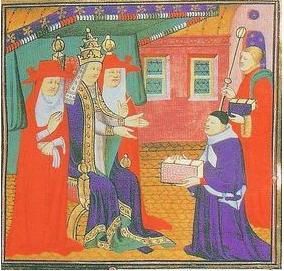
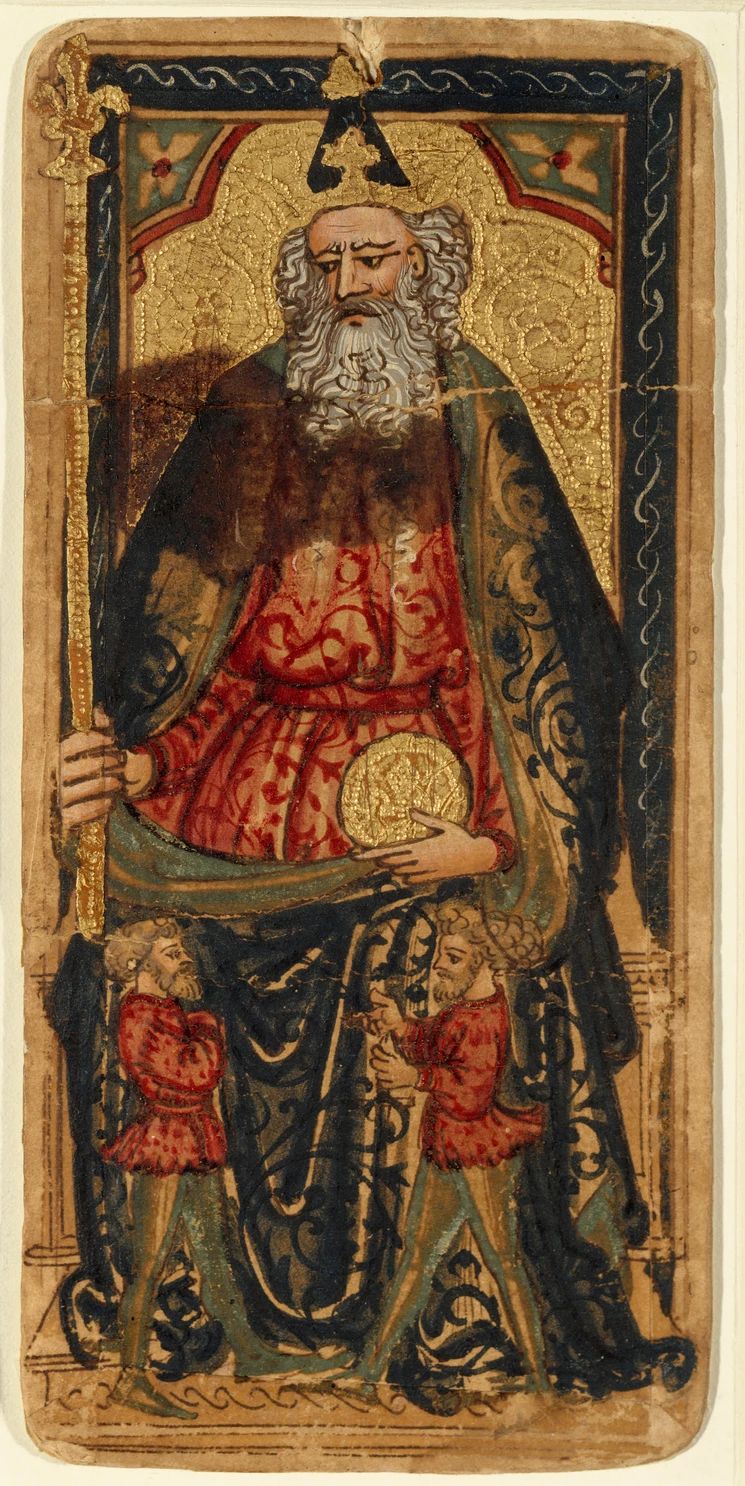

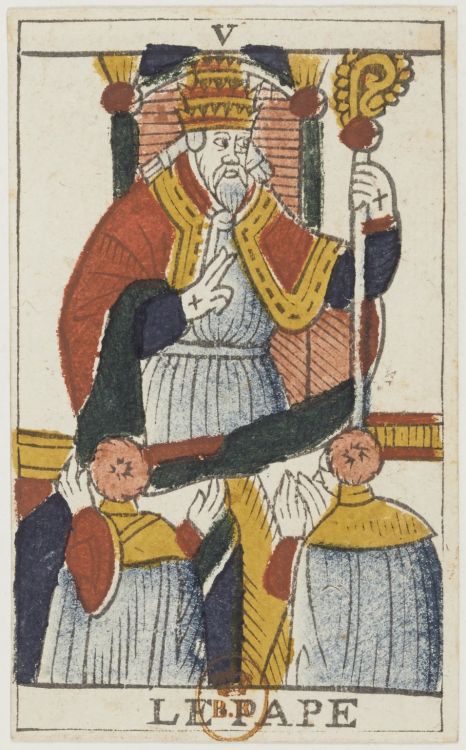

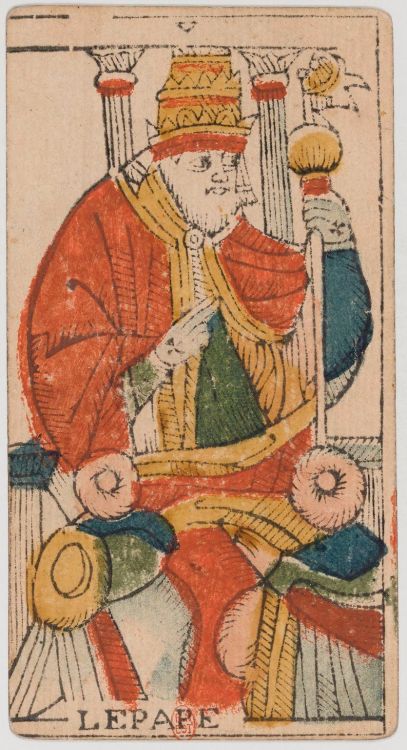


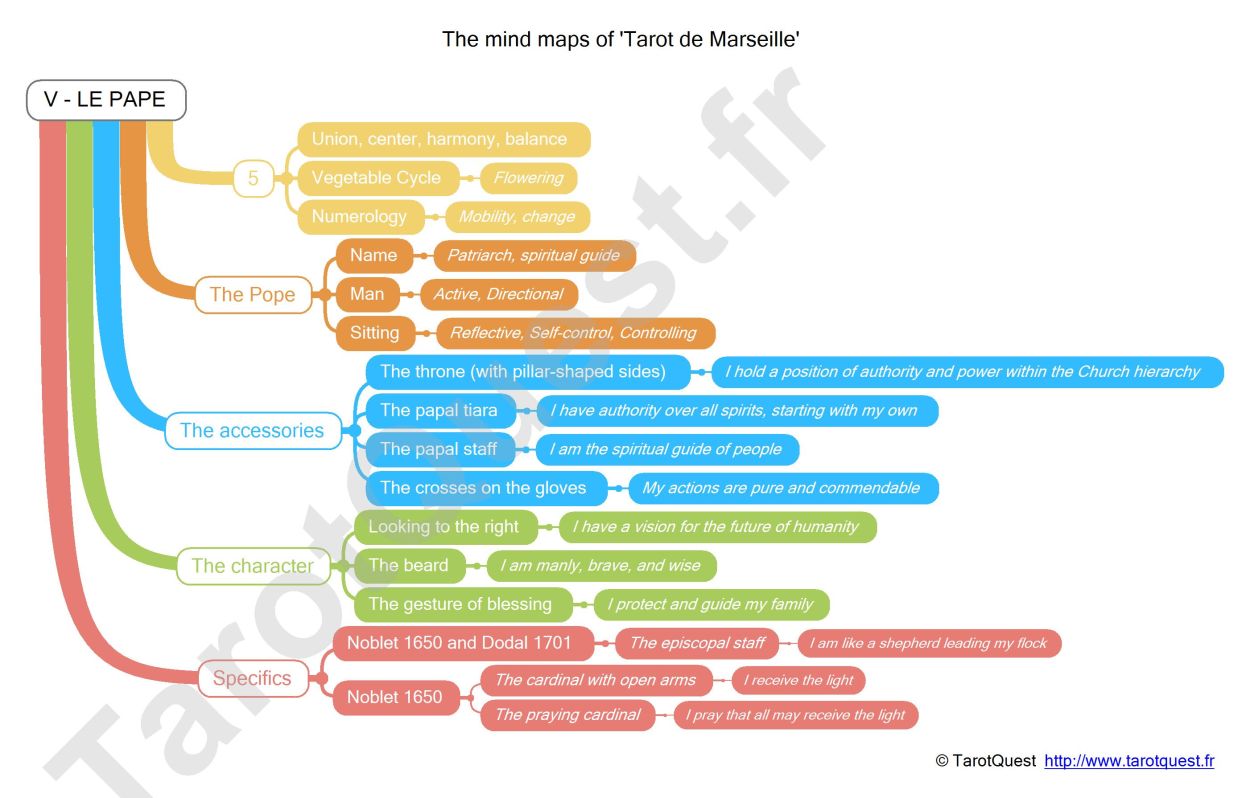
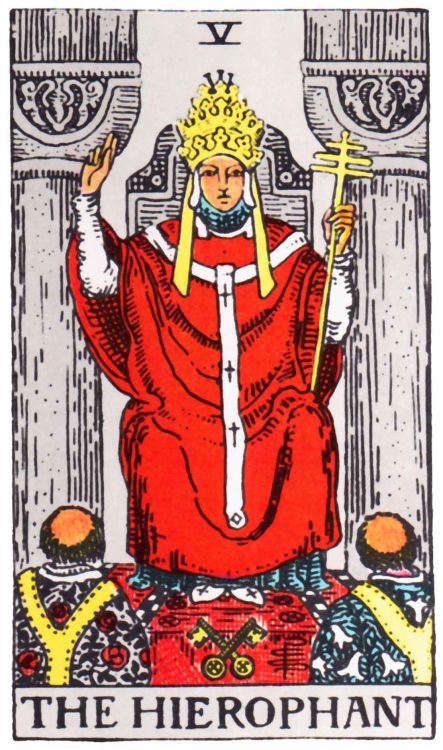
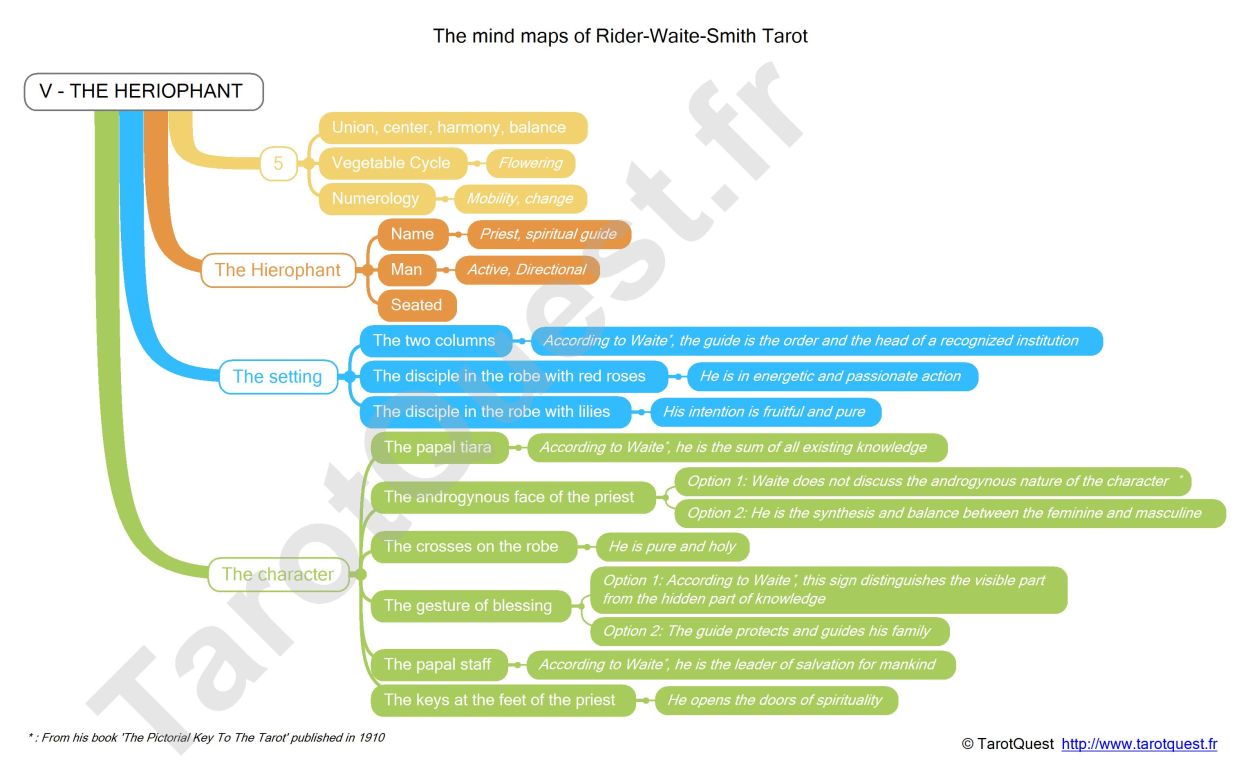

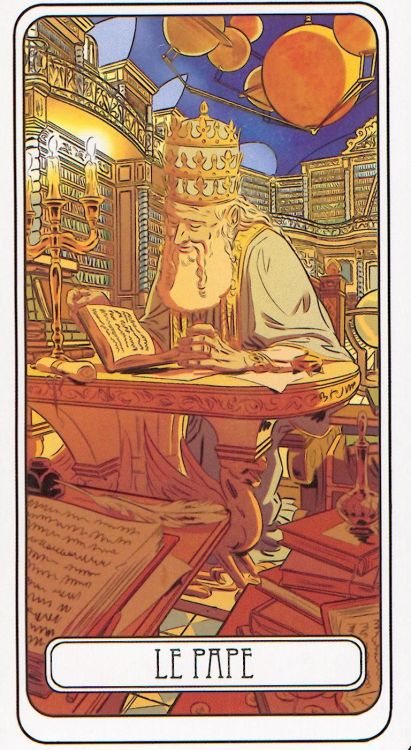
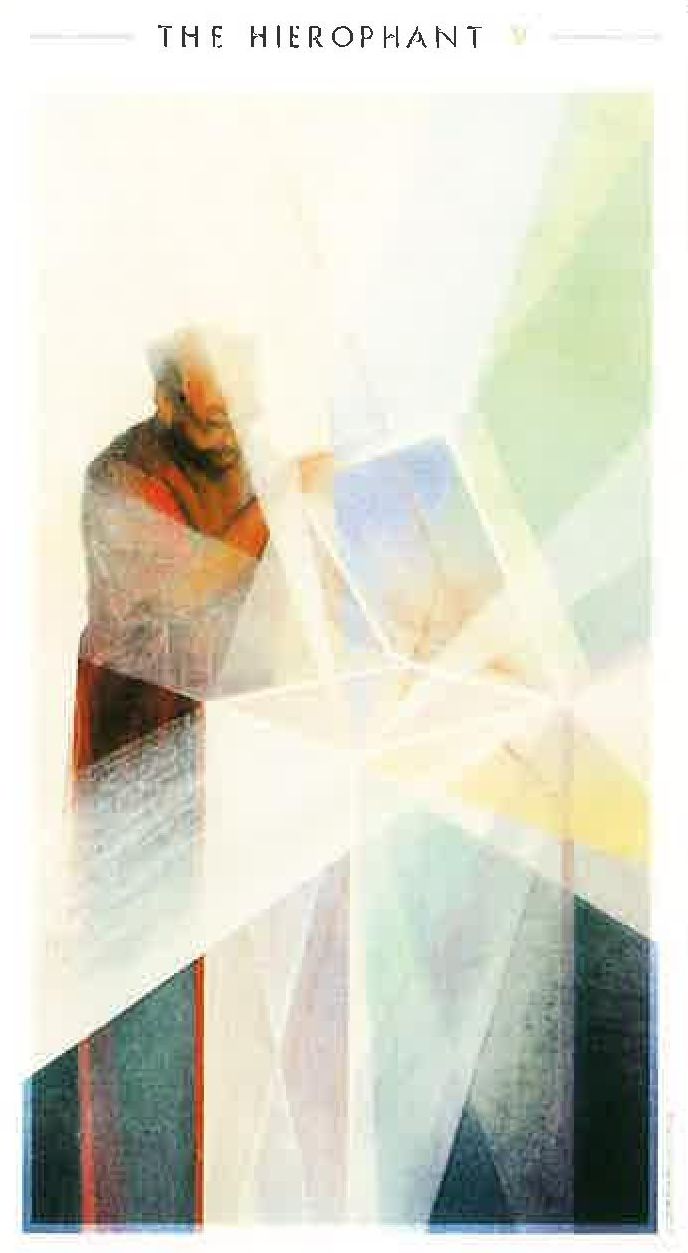
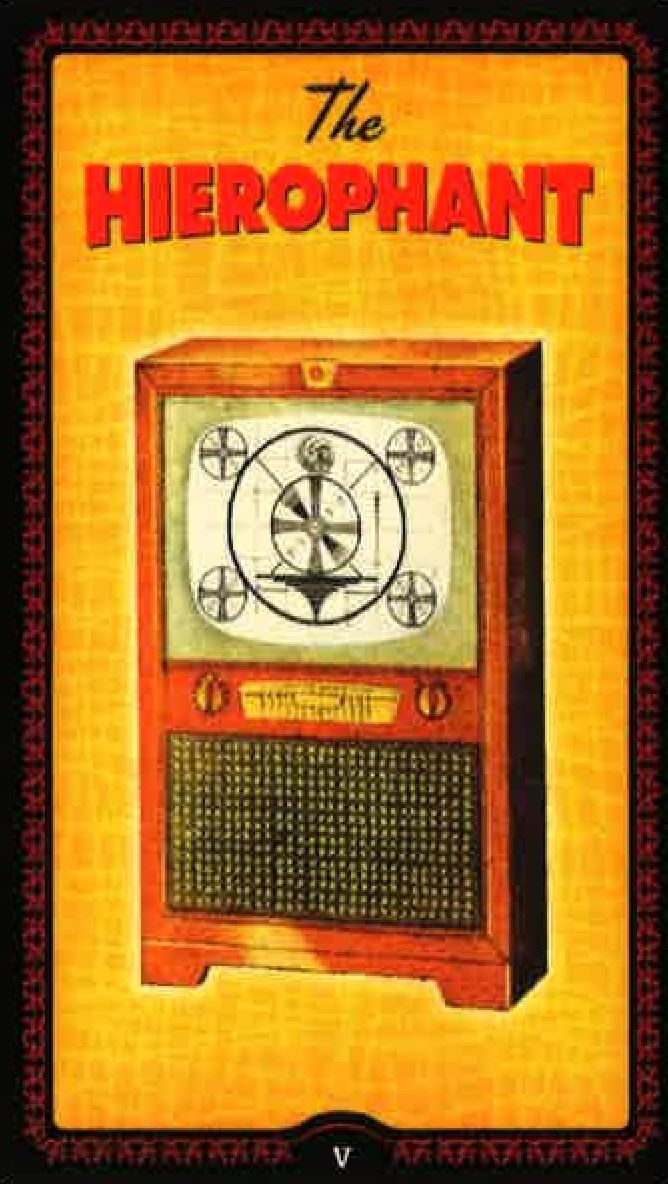
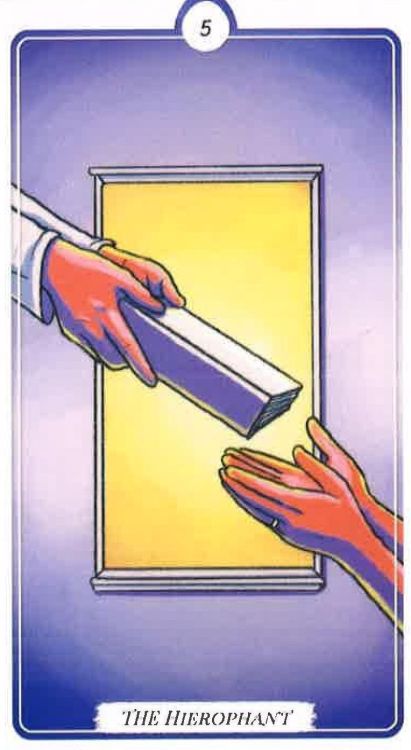
Copyright © TarotQuest.fr